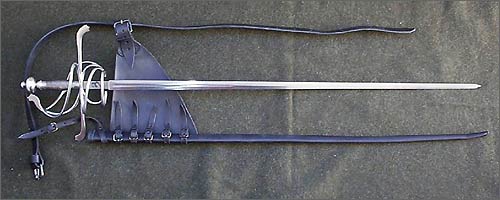
 |
|
|
|
|||||||||||||||||
|
K + K Art RA-4.3 Early 17th Century Practice Rapier
A hands-on review by Björn Hellqvist Introduction When a friend on the Swedish ARMA (Association for Renaissance Martial Arts) list asked whether anyone would be interested in rapiers from the Czech Republic, I thought it was a good opportunity to test the products from the maker in question, Overview The rapier I opted for, the RA-4.3, is a generic early 17th century European design. As the rapier is intended for training, it is supplied with a blunted blade that doesn't really echo the originals. I ordered a scabbard and belt with rapier hanger, the ZA-7.1 as well, as I wanted the option to wear it with a costume.  Measurements and Specifications:
Price as of mid-October 2003: Rapier: $118 US; Scabbard, belt and hanger: $59 US; (Total $177 US), shipping not included. Replica created by K + K Art of the Czech Republic. Handling Characteristics The rapier handles well enough, but the loose hilt (see below) makes it anything but a pleasure to wield. The pivot point is a bit up the blade, which is bad for the point control so important in rapiers. The blade is rather stiff, which calls for good protection if this sword is used for sparring. It flexes about halfway down the blade, when it would be preferable if it flexed in the outer third instead, lessening the need for substantial protection. Fit and Finish The craftsmanship is similar to what one can see in Indian and Philippine swords in the same price range, minus the nickel plating prevalent in the Asian swords. The welds on the hilt are fairly well made, the whole thing steel-brushed to a rather rough finish. The dimensions of the quillons, bars and guards are within historical parameters, but nothing fancy. A word of warning: on my rapier, the spatulate ends of the quillons and the knuckle-bow had rather sharp corners, which needed some file-work in order to avoid injury. The pommel shows signs of being turned, but not glaringly so. The grip is wound with twisted steel wire, and actually the nicest part of the whole weapon, as it is well made and tight. The blade has copious grind marks that are very slight, but giving it a matte finish. The flat edges are about 1.5 mm thick, but the point is rather pronounced, and will need some filing-down and a rubber blunt in order to be safe for serious sparring. The ricasso is stamped with a prominent eagle-head and sword mark, the mark of K + K Art. The rapier arrived loose in the hilt. The blade, grip and pommel were tightly mounted, but the hole in the quillon "block" wasn't small enough to provide a tight fit. No amount of twisting the pommel could tighten the assembly or loosen it; a problem with weapons intended for sparring. It would be nice to be able to change the blade, at least. A dab of "cutler's pitch" (epoxy glue) will be needed in order to get rid of the rattling. The scabbard consisted of a single piece of machine-sewn heavy leather, reinforced with a narrow leather throat. Unfortunately, the scabbard appeared to have been made for a narrower blade, as it didn't accept the RA-4.3's entire blade. There might have been some confusion in the ordering process, as I ordered a narrower rapier at the same time. With the blade not going in all the way, the last couple of inches of the scabbard were prone to bending, which looked a bit silly. The hanger and belt were likewise of heavy black leather. The belt was decent (after all, it is hard to mess up a belt), but the hanger left something to be desired, being of rather stiff leather. After experimenting and some research, I was able to figure out how the thing was to be worn. Acceptable stuff, but nothing more. Conclusion Do I recommend this rapier? Only if one is looking for a cheap stage combat weapon, or an accessory for a moderately accurate costume. It doesn't display anything that would recommend it to the serious collector. For my own part, I will sell my RA-4.3 as soon as possible. About the Author Björn Hellqvist is a Swedish optometrist with an interest in historical European swords. |
|||||||||||||||||